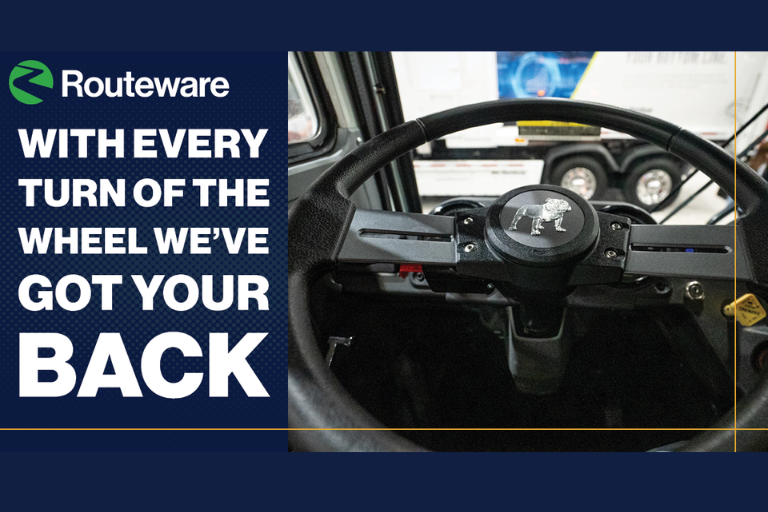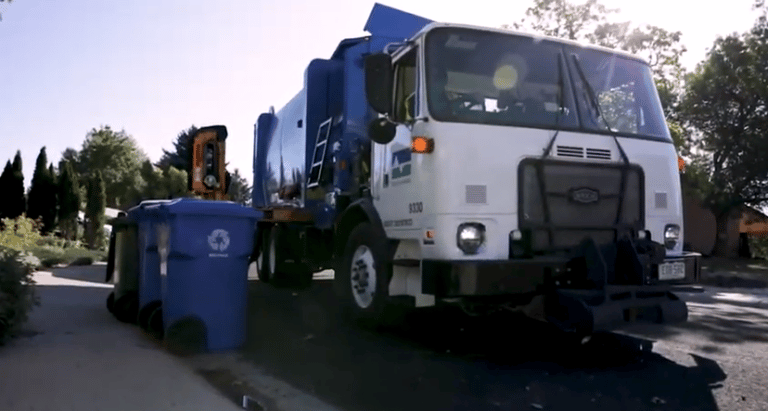Blog
Route Optimization: With Every Turn of the Wheel, We’ve Got Your Back
by Routeware Team • November 18, 2024

Routeware started off selling route optimization software – it is, quite literally, the foundation of our name.
Even as our solutions have expanded and evolved over the decades, route optimization has only become more of a priority for our customers. As the prices of gas, labor, and equipment continue to increase, saving fuel and time on routes, reducing wear and tear on trucks, and providing drivers with more balanced schedules is more important than ever.
Additionally, with shifting market conditions, rapidly fluctuating service populations, and driver turnover and absence, staying dynamic and flexible with routing has never been more essential.
Routeware has grown and evolved since we first tackled the routing challenge over twenty years ago, but one thing remains very much the same: we’ve got your back at every turn.
When private hauler Meridian Waste, headquartered in Charlotte, NC, undertook route optimization in one of its markets, it freed up 34 percent of solid waste vehicles and eliminated 26 percent of trash routes while reducing route miles and related emissions by 21 percent. Additionally, they were able to phase out aging collection vehicles without the need to replace them.
How Our Routing Optimization Software Helps
Costs Down, Profits Up
By conservative estimates, digitally-aided route optimization projects generally create a cost saving of 10 to 15 percent. How? Optimized routes use fewer trucks, need fewer drivers, and consume less fuel.
Making the most of resources is at the heart of optimization. Placing the right trucks and drivers in the right places at the right times delivers the efficiencies that make undertaking route redesign worthwhile.
American Refuse, a private hauler located in California, can now complete rerouting to accommodate additional customers in about two hours, allowing the business to scale. “The software is the heartbeat of the company,” says Jeff Martin, Owner of American Refuse.
Another way to grow profitability is to increase route density. If your trucks are passing prospective customers on their daily routes, that’s an opportunity you shouldn’t miss. It may be as simple as sending marketing communications to businesses in close proximity to your existing routes, or you may offer more competitive pricing to customers that are easier for you to serve.
As you bring new customers on and route density increases, you’ll need to look at optimizing and rebalancing route plans. That’s why Routeware offers route optimization tools designed to intelligently sequence and balance stops as part of our platform. By distributing work more effectively across routes, haulers can accommodate growth in customer numbers while using fewer trucks and staff.
Time is Money
When time is of the essence, it’s especially important that software tools are easy to master.
Routeware’s route optimization tool is “easy to use and easy to train”, said Sean Steves, Senior Vice President and Chief Operating Officer of Solid Waste Operations for Casella Waste Systems, Inc. “We have experienced great success with utilizing the tool across the full spectrum of route optimization.”
Route optimization software is the fastest way to plan more efficient waste collection routes – enabling you to implement new routes that reduce costs and emissions while balancing human resources. Digital route planning can be done in a fraction of the time compared to manual, paper-based processes. This means you can re-balance routes more frequently and deliver them to drivers much faster.
In Loveland, CO, “Drivers used to finish so late, they weren’t able to do daily maintenance.” Now – thanks to route optimization – the number of stops per route decreased by 30 percent, meaning drivers finish earlier, complete daily maintenance, get home to their families, and keep their vehicles safe.

Jeremy Stewart, Business Analyst – Loveland, CO
Plus, in-cab computers connecting trucks to the back office provide instantaneous communications to ensure that costly, one-off bin collection scenarios – like going back to collect a missed bin or non-collection of a contaminated bin – are minimized or resolved as efficiently as possible.
Digital in-cab communications allow supervisors to notify the nearest crew immediately so a problem can be dealt with quickly and without unnecessary miles or a costly return visit. On-board computers dramatically improves customer service by providing residents with up-to-the-minute route information, reducing case resolution times.
Onboarding & Routing Simplified
Municipal and private haulers used to redesign routes a few times in their careers. As neighborhoods changed, longtime drivers made accommodations and improvised alongside their colleagues to make things work.
The most complex rerouting projects likely involved paper maps, a whiteboard, and several hours in the conference room. Generally, the analysis ended there; and everyone would simply have to hope that they’d made the correct routing choices.
Today, solid waste collection – and indeed the entire waste industry – is in the midst of an ongoing digital transformation. Many waste haulers have abandoned legacy waste collection routing processes in favor of digital solutions, and forward-looking leaders are taking things a step further by focusing on efficient, agile solutions that consider future route changes, as well as inefficiencies within current waste collection routes.
At Casella Waste Systems, a recent acquisition project reduced miles by 21%, cut fuel use by 5,000 gallons/year, and prevented 52 metric tons of emissions/year. Plus, a quicker routing process for new routes leads to faster integration overall, including quicker insights into return on investment.
Routeware’s solution employs advanced algorithms to guide the optimization process. Additionally, fleet managers can layer in additional criteria (e.g. narrow streets, required turns, low bridges, etc.) and other street data to further refine the route optimization. To solve those problems, fleet managers can edit travel paths directly in the software, enabling the routes to remove undesirable streets or make required turns at certain intersections or hard to service streets.
These custom routing sequences can be uploaded directly into the fleet management dashboard for immediate implementation. On-board computers that provide complete route information and turn-by-turn directions offer guidance and eliminate guesswork, allowing new and veteran drivers alike to feel confident about their work. With the use of tools such as these, driver training in Loveland, CO, has been reduced from three months to just two weeks.
“We can train a person to run a trash truck in two weeks, and after that, we can just let them go,” said Crew Supervisor Nathan Rasmussen. With on-board tools, “they don’t need to know the routes or the streets.”
Sustainability Savvy
The role of solid waste in global warming is not insignificant – the industry is responsible for more than 3 percent of greenhouse gas production annually. That means there are many opportunities to decrease emissions and meet critical sustainability goals.
In an industry that involves visiting every address on the map with heavy trucks multiple times per month, along with load hauling and decomposition on a massive scale, only a concerted effort on multiple fronts will make a dent in greenhouse gas production. As cities and private fleets implement longer-term initiatives, like shifting to EV vehicles and capturing landfill emissions, digital solutions such as route optimization are a valuable tool for meeting sustainability goals.
Fleets that undergo regular route optimization exercises improve their fuel efficiency and reduce vehicle wear-and-tear. Our technology provides municipalities and haulers with detailed analytics to help them plan and quantify greenhouse gas reduction strategies and cost saving targets.
Lexington, KY, was able to reroute collections of 360,000 carts across garbage, recycling and yard waste streams – over a million service points – in just three months with Routeware’s route optimization software. By planning and resourcing properly, and selecting the right tool, the city saved considerable time on a project that previously would have taken two years.
Stay flexible, nimble, and ready to win. Use Routeware’s Routing Software.
Takeaways
Routeware route optimization technology saves on time, money, and emissions, all while keeping your fleet operations flexible and agile enough to deal with any and all changes that come your way.
The days of one-and-done, paper-based route optimization are past. Today’s forward-thinking fleet operators are working toward increased agility and resilience within a continuous improvement model and digital solutions.
As populations grow, new collections are added and others are removed, collection weights go up and down, and crew and fleet makeup changes over time. Those fleet operators who commit to keeping data up to date in a continuous fashion will realize the greatest efficiencies in their operations while saving money for their organizations.
Waste collection route optimization is one of the most important steps towards sustainable, cost-effective operations. Routeware’s expertise can help you make this first step.
Gaeta Green Environmental Services, a private hauler located in New York, improved routes, optimized system data, and decreased mileage and associated emissions. “Routeware has definitely helped with efficiency. We analyze our routes using the breadcrumbs feature, which helps us cut down on emissions to fulfill our environmental mission.”

Rachel Lattanzio, Chief Operations Officer – Gaeta Green Environmental Services
Interested in learning more about what we can do for you? Get Started today with your initial quick and free consultation.